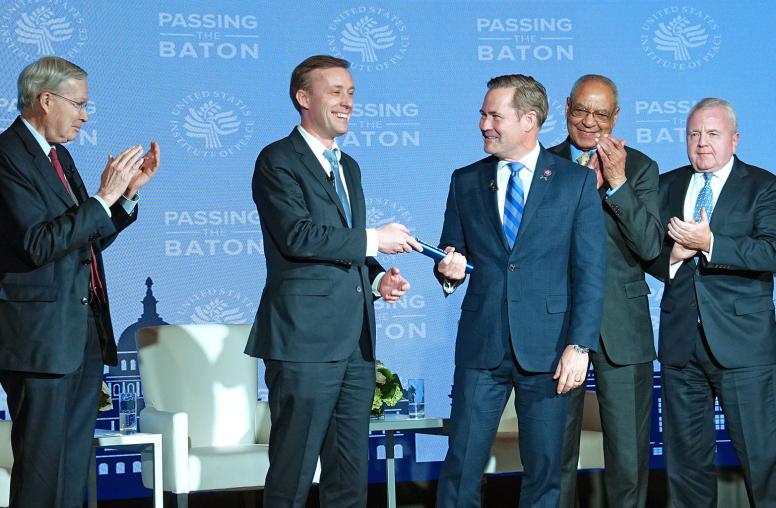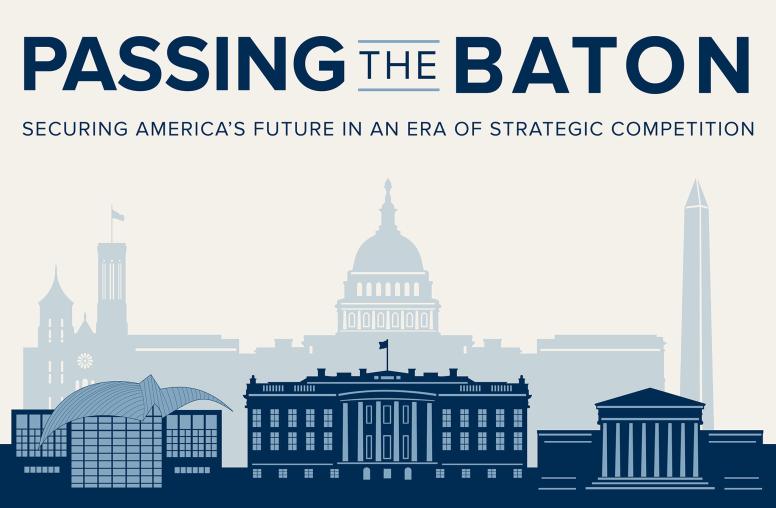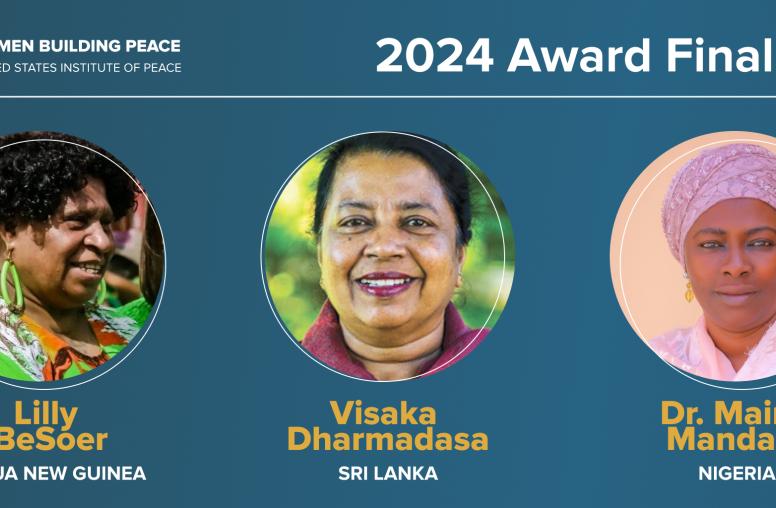Understanding North Korean Negotiating Behavior
Institute book on North Korean negotiating behavior available.
WASHINGTON--Journalists and others seeking to understand the strange machinations of Kim Jong Il and the North Korean regime would do well to read Negotiating on the Edge: North Korean Negotiating Behavior by Scott Snyder, published in 1999 by the U.S. Institute of Peace Press.
Scott Snyder, a former program officer with the Institute, now with the Asia Foundation in Seoul, explains in the book that the North Koreans' disturbing penchant for confrontation, threats and violence should not be dismissed as lunacy or behavior not to be dignified with a reaction. Rather, he argues, it is part of a predictable pattern of behavior that must be studied and understood if the U.S. government and the West are to respond effectively to the current provocations from Pyongyang.
In the book, Snyder focuses on bilateral and multilateral negotiations between North Korea, the United States and other countries during the 1990s. In so doing, he provides valuable insight into the thought processes of a mysterious and reclusive leadership sect.
Other recent Institute resources on Korea include:
- The Great North Korean Famine: Famine, Politics and Foreign Policy
by Andrew S. Natsios (2001, U.S. Institute of Peace Press). - North Korea's Nuclear Posture: Policy Options for the United States
USIPeace Briefing, December 2002 - Overcoming Humanitarian Dilemmas in the DPRK (North Korea)
Special Report, July 2002
An Excerpt from Negotiating on the Edge
CONTENTS
An Introduction...
On June 4, 1993, Vice Foreign Minister Kang Sok Ju of the Democratic People's Republic of Korea (DPRK) and his delegation arrived at New York's John F. Kennedy International Airport to participate in negotiations stemming from North Korea's decision to withdraw from the Nuclear Non-Proliferation Treaty (NPT). The delegation was greeted by the director of the State Department's North Korea desk, C. Kenneth Quinones, and an armed customs official, who escorted the delegation to a special area for questioning and immigration processing. Having arrived in the United States for diplomatic negotiations at a time of high crisis that could possibly lead to war, the North official of the U.S. government with alarm. At this moment of high tension, it was not a greeting that inspired trust among Kang and his delegation, who had come to New York for high-level political talks as part of a last-ditch U.S. effort to convince North Korea not to follow through on a March announcement to withdraw from the NPT, a decision that was scheduled to take effect the following week, on June 12. If these talks failed, the United States threatened to lead a drive at the United Nations for international economic sanctions, a measure that North Korea had announced it would regard as an act of war. The stakes could not have been higher in these negotiations between two countries with no diplomatic relations and little previous official contact.
North Korea, an isolated and seemingly impenetrable state that had managed somehow to survive the collapse of communism in the rest of the world, sought to achieve its diplomatic objectives and maintain the survival of its regime by engaging the United States, a distracted superpower with a new president who had been elected on a domestic agenda and had little experience in foreign relations. Moreover, U.S. negotiators had almost no idea of what to expect from North Korean officials. With the exception of a single high-level meeting the previous year in New York between Arnold Kanter, the Bush administration's under secretary of state for political affairs, and Kim Yong Sun, secretary for international relations of the Korean Workers' Party of the DPRK, the U.S. and North Korean governments had not been involved in high-level political negotiations since the 1951-53 armistice negotiations that ended the Korean War.
When Minister Kang arrived at the door of the U.S. mission to the United Nations the following day, he was again greeted by the State Department's Ken Quinones. It was only after Minister Kang was escorted inside the mission that he finally met his negotiating counterpart, Robert L. Gallucci, assistant secretary of state for political-military affairs. Although Kang may have perceived the low level of his initial greeting as a slight, it was politically impossible for the State Department to conceive of the American media reporting a live, public greeting between Kang and a senior administration official at the doorway of the U.S. mission to the United Nations, particularly given the perceived audacity of North Korea to announce that it would flout the international regime designed to prevent nuclear proliferation. The atmosphere inside was initially tense and uneasy as long-time adversaries shared coffee before sitting down to a make-or-break negotiation with serious implications for war or peace in Northeast Asia. There was little allowance for small talk between delegations on either side, and there were virtually no previously existing relationships or common experiences between delegation members on either side that might have helped break the ice. Yet the task of the two delegations was to find mutually acceptable areas of agreement that might lead away from confrontation over the future of North Korea's nuclear program.
Decades of distrust and miscommunication between the United States and North Korea had created a difficult atmosphere for dialogue before official negotiations had started. In the eyes of the U.S. public, the North Korean government was irrational, "crazy," violence-prone, and unpredictable, precisely the type of adversary that is not amenable to negotiations. Such images had accumulated over decades since North Korea initiated the Korean War in 1950. Subsequently, American images of North Korea were shaped by aggressive terrorist acts such as the capture and yearlong ordeal of the crew of the USS Pueblo in the late 1960s; the "axe murder" and other incidents at the demilitarized zone (DMZ) during the 1970s; the North Korean assassination of over half the South Korean cabinet in 1983 in an attempt to kill President Chun Doo Hwan; and the downing of KAL flight 858 in 1987 in retaliation for Seoul's successful bid to host the 1988 Olympics. At any mention of North Korea in the news, there was also the TV file footage of a million-man army goose-stepping in lockstep formation across the vast public square in Pyongyang. At the height of deliberations over the proper response to the grisly axe murder incident in 1976, for instance, then Deputy National Security Adviser William Hyland is reported to have described the North Korean leadership as "wild people."
This assessment of the North Korean leadership as irrational, violent, and unrestrained was still typical in Washington almost two decades later, throughout the U.S.-DPRK nuclear negotiations and during the nuclear crisis of 1994. Paul Wolfowitz, under secretary of defense during the Bush administration, remarked, "I'm more profoundly skeptical of North Korea than of any other country--both how they think which I don't understand, and the series of bizarre things they have done." In similar vein, another senior official recalled that "the basic assumption in the intelligence community and in Defense was that these people are liars, they dug tunnels and you couldn't trust any agreement that you reached with them."
Assistant Secretary Gallucci's objective in the nuclear negotiations in New York was to convince the "irrational" North Koreans to refrain from fulfilling their publicly announced plan to withdraw from the NPT. Furthermore, Gallucci had to convince North Korea to return to full compliance with treaty obligations, including International Atomic Energy Agency (IAEA) demands for special inspections of North Korea's undeclared facilities suspected of being storage areas for reprocessed plutonium that could be used for making nuclear weapons. In return, Gallucci had "nothing to trade," and concrete institutional experience in political negotiations with North Korea was practically nonexistent. "It was the thinnest briefing book I ever had in my life," Gallucci said of instructions given to him in advance of the June 1993 meetings in New York. According to one State Department official present at the talks, the experience of negotiating directly with the North Koreans in the context of an impending confrontation was "sort of like learning how to fly while you are rolling down the runway."
The negotiations with North Korea were an on-again, off-again sixteen-month ordeal for the Americans that eventually resulted in the Geneva Agreed Framework of October 21, 1994, a complex agreement between the United States and North Korea to freeze and eventually dismantle North Korean nuclear facilities that could be used to manufacture fuel for nuclear weapons in return for the provision of technologically superior, proliferation-resistant light-water reactors (LWRs) and of 500,000 tons per year of heavy fuel oil (HFO) to North Korea. Given the context and atmospherics surrounding the negotiations and the bitter history of military confrontation between the two nations, it is surprising that the United States and the DPRK--two nations with very different historical perspectives and perceptions of their relationship to the international community--would be able to come to an agreement at all. In June 1994, almost everyone--including some members of the U.S. negotiating team itself--was privately predicting failure, if not for the negotiations themselves, then for the process of implementation, which survived for over five years following the negotiation of the Agreed Framework in 1994.
These two nations of vastly different size, power, ideological persuasion, and historical experience were separated not only by intractable negotiating positions but also by very different experiences and ways of looking at the world--differences that were exhibited by the negotiating strategies and tactics of both parties. What can be learned about patterns in North Korean strategies and tactics as a result of the American negotiating experience? And to what extent do both the cultural context of decision making and the expressions of particular national negotiating patterns influence the process and outcome of a negotiated settlement? In what ways do differences in background, experience, and culture influence the negotiation of an agreement, and how is it possible to reconcile differing approaches to problem solving with the respective national interests of the United States and the DPRK? How might understanding such patterns enhance the ability of American negotiators to understand North Korean negotiating strategies and tactics and respond effectively to them?
The Cold War Negotiating Experience with North Korea
Although the U.S.-DPRK negotiations over North Korea's nuclear weapons program in 1993 between Assistant Secretary of State Gallucci and Vice Foreign Minister Kang initiated the first sustained political negotiation process between the two countries in over four decades, various negotiation channels and venues with North Korea have existed since the armistice negotiations to end the Korean War in 1951-53. In fact, rather extensive source materials are available on the armistice negotiations involving the United States, the People's Republic of China (PRC), and the two Koreas. Regular low-level technical contact between the militaries has been consistently maintained through the Military Armistice Commission, the vehicle through which military violations of the Armistice Agreement itself have been discussed and resolved. After two decades of silence during the fifties and sixties, a historic step to reinitiate inter-Korean political dialogue was taken by Kim Il Sung and Park Chung Hee with the signing on July 4, 1972, of the South-North Joint Communiqué which laid out three principles for national unification. This first step toward inter-Korean rapprochement opened the way for significant further communication, and there is now a rich record of intermittent crisis-focused contacts, dialogues, and negotiations between the two Koreas stretching back to the early 1970s.
Initial perceptions of North Korean negotiating behavior were shaped primarily by the experience of negotiating the Korean armistice with Chinese and North Korean communists at Panmunjom during 1951-53. The landmark study of the armistice negotiations that has shaped American perceptions of North Korea's negotiating style is How Communists Negotiate, by Admiral C. Turner Joy, the lead negotiator in the armistice talks. Turner Joy's first-person account identifies and magnifies the negotiating strengths of his counterparts while simultaneously vilifying their motives and intentions. Most notable among the tactics Turner Joy describes are attempts to "load" the agenda in order to create a context for one-sided concessions, psychological warfare conducted through incidents away from the negotiating table, delaying progress in order to wear down the opponent, making minimal commitments while extracting maximal concessions, dishonoring commitments already made, maintaining a veto in practice over the enforcement of agreements, raising "red herrings" in the course of negotiations, denying or distorting the truth, pocketing concessions instead of offering an equal concession in turn, and agreeing to an item in principle and later applying a different interpretation to its content or significance. "Communists are not embarrassed in the least to deny an agreement already reached," says Turner Joy, "[they] simply state your interpretation is an incorrect one."
A recent study by Chuck Downs analyzing the implementation and maintenance of the armistice through negotiations between the DPRK and the United Nations Command (UNC) via the Military Armistice Commission (MAC) underlines many of the patterns in North Korean negotiating behavior observed by Admiral Turner Joy. Although intended as a temporary mechanism for maintaining the peace, the MAC has now been in place for almost fifty years, during which time it has often served as the only vehicle for international negotiation with North Korea, usually during periods of crisis. Following negotiation of the armistice, the MAC quickly devolved into a venue for competition by peaceful means, with adversaries "acting out" aggression for propaganda purposes and testing each other through limited provocations. When tensions came close to reaching breaking point during the Pueblo incident of 1968, periodic border helicopter incursions, and the axe murder incident, the MAC was by default the only diplomatic vehicle through which such incidents could be settled, and thus provides a reservoir of experience with North Korean propaganda tactics. At the same time, the MAC's technical negotiations have been restricted in their purpose to issues related to the implementation of the armistice and are limited in their scope.
The 1972 Red Cross negotiations between North and South Korea marked the first direct inter-Korean contact since the end of the Korean War and the initiation of an on-again, off-again series of negotiations between North and South Korea over economic matters, sports exchanges, and political issues. The sporadic but growing negotiating record of North-South dialogue that has built up in the past quarter century on economic, cultural, political, and sports-related issues is characterized by a zero-sum approach–the perpetuation of North-South competition for legitimacy through means other than war. This quarter century of interaction between North and South Korea has reinforced Cold War perceptions of North Korean negotiating behavior among Americans, since the United States and South Korea have regularly shared viewpoints, experiences, and lessons learned from their negotiating experiences with North Korea.
Kim Do Tae of the Korea Institute of National Unification, in a study that analyzes over two decades of inter-Korean dialogue, concludes that North Korean negotiating objectives are related to its effort to "safeguard its political system and to attempt, together with physical force, to achieve unification on Communist terms." In typical negotiations with South Korean counterparts, North Korea's real agenda is not reflected at the table; rather, the purpose of negotiation, or "pseudo-negotiation," is to allow North Korea to pursue ancillary objectives separate from those of the negotiation itself, such as positively influencing North Korea's international standing or denying potential benefits to South Korea. Also, North Korean pursuit of "incidental effects from the negotiations" rather than a negotiated settlement itself is usually designed to prevent South Korea gaining any benefit from a negotiated outcome, even if such an agreement might also be of benefit to the North.
These studies of North Korean negotiating behavior during the Cold War emphasize the communist approach to the negotiation process as "war by other means." Although this approach may indeed characterize some aspects of North Korean negotiating behavior even today, its wholesale application as a model for understanding current North Korean negotiating behavior is limited in several respects. First, the armistice was negotiated and implemented while hostilities were in progress, creating a very different context for negotiation than that which exists today, after over four decades of stalemated confrontation punctuated by occasional episodes of violence. Second, Turner Joy's analysis reveals that aspects of the negotiating behavior he encountered have more to do with Chinese and Korean cultural styles than the influence of communist ideology, yet this fact is unacknowledged in Turner Joy's narrative. Third, the Korean armistice negotiations were led in large part by the Chinese, and thus are not fully reflective of patterns in North Korea's negotiating style. Fourth, Soviet records regarding the Korean War that were released in the mid-1990s have shown that the prolongation of armistice negotiations was influenced significantly by Stalin's desire to take a hard line as a means by which to drag out the war and thus weaken the capacity of the United States to build its capabilities in anticipation of a broader global conflict. Despite an increasing desire on the part of North Korean and Chinese leaders to end the war as the conflict dragged on during 1952, it was only after Stalin's death in March 1953 that the Soviet Council of Ministers advocated a rapid conclusion of the Armistice Agreement, which was finally accomplished only four months later.
Finally, patterns in North Korean negotiating behavior during the Cold War were influenced by the extent to which North Korea was able to project its power vis-à-vis the South. Chinese and Soviet backing put North Korea into a powerful position in the armistice negotiations in which the cessation of hostilities and the end of confrontation arguably would be of greater advantage to the opponent than to the North Koreans themselves. However, the end of the Cold War has significantly changed the structural environment of a now abandoned and isolated North Korea. Under current circumstances–in which the North Koreans must attain concrete objectives that can be realized only through a negotiation process–North Korean negotiation strategy cannot simply be "war by other means"; rather, North Korea must pursue negotiations in order to attain benefits of agreement necessary for regime survival. However, one-upmanship and intense zero-sum competition in inter-Korean negotiations have made it difficult for both sides to break even after the end of the Cold War, with breakthroughs in inter-Korean dialogue thus far only occurring during periods in which dramatic external changes have affected the relationship between Pyongyang and Seoul.
Copyright 1999 — All Rights Reserved.
About the Author
These selections are from the book Negotiating on the Edge by Scott Snyder.
Scott Snyder was a program officer in the Research and Studies Program of the United States Institute of Peace, where organized a working group on U.S. policy towards North Korea. The author was a program officer in the Research and Studies Program of the United States Institute of Peace, where organized a working group on U.S. policy towards North Korea. The author of numerous articles, Snyder has been an Abe fellow and a staff member of the Asia Society.



